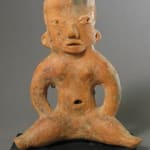Olmecoid Sculpture of a Seated Figure, 1150 BCE - 550 CE
Terracotta
8
PF.2585
Further images
The Olmecs are generally considered to be the ultimate ancestor of all subsequent Mesoamerican civilisations. Thriving between about 1200 and 400 BC, their base was the tropical lowlands of south...
The Olmecs are generally considered to be the ultimate ancestor of all subsequent Mesoamerican civilisations. Thriving between about 1200 and 400 BC, their base was the tropical lowlands of south central Mexico, an area characterized by swamps punctuated by low hill ridges and volcanoes. Here the Olmecs practiced advanced farming techniques and constructed permanent settlements. However, the consolidation of their city-states led to notable cultural influence far beyond their heartland, and throughout the Mesoamerican region. It would appear that the Olmec style became synonymous with elite status in other (predominantly highland) groups, with evidence for exchange of artefacts in both directions. A non-literate group, the Olmecs nevertheless paved the way for the development of writing systems in the loosely defined Epi- Olmec period (c. 500 BC). Further innovations include arguably the first use of the zero, so instrumental in the Maya long count vigesimal calendrical system. They also appear to have been the originators of the famous Mesoamerican ballgame so prevalent among later cultures in the region, and either retained or invented several religious symbols such as the feathered serpent and the rain spirit, which persisted in subsequent and related cultures until the middle ages.
Comparatively little is known of their magico- religious world, although the clues that we have are tantalizing. The art forms for which the Olmecs are best known, the monumental stone heads weighing up to forty tons, are generally assumed to pertain to some form of kingly leader or possibly an ancestor. The smaller jade figures and celts are believed to be domestically or institutionally based totems or divinities. The quality of production is astonishing, particularly if one considers the technology available for production, the early date of the pieces, and the dearth of earlier works upon which the Olmec sculptors could draw. Some pieces are highly stylized, while others demonstrate striking naturalism.
The term “Olmecoid” refers to those unknown cultures that lived on the periphery of the Olmec and were highly influenced by their neighbor. As such, Olmecoid works of art reflect stylistic tendencies characteristic of the greater Olmec culture, albeit mixed with their own indigenous qualities.The state of Morelos is located in the Mexican highlands, south of the valley of Mexico. Warm and even subtropical during the middle pre-classic period, this region may well have proved attractive to the famous Olmec people who lived to the southeast. Clearly, their tremendous cultural influence was felt in this region of central Mexico; a fact attested to by the distinctive ceramics that appear from Morelos during this time period.
Here, we see one such remarkable piece, presented in the form of a seated figure. The distinguishing Olmec features include the somewhat puffy, infantile features of the figure as well as the shape of the head, with its pierced slanted eyes and downward turned mouth. Seated, with hands resting on outstretched legs, and a dramatic vent hole positioned at the navel, this ceramic figure exudes a spirited energy that is characteristic of Olmec-type ceramics. A mastery of form combines with an imaginative portrayal to give us a work of art that is a dramatic manifestation of the interaction of cultures, whether they be friend or foe.
Comparatively little is known of their magico- religious world, although the clues that we have are tantalizing. The art forms for which the Olmecs are best known, the monumental stone heads weighing up to forty tons, are generally assumed to pertain to some form of kingly leader or possibly an ancestor. The smaller jade figures and celts are believed to be domestically or institutionally based totems or divinities. The quality of production is astonishing, particularly if one considers the technology available for production, the early date of the pieces, and the dearth of earlier works upon which the Olmec sculptors could draw. Some pieces are highly stylized, while others demonstrate striking naturalism.
The term “Olmecoid” refers to those unknown cultures that lived on the periphery of the Olmec and were highly influenced by their neighbor. As such, Olmecoid works of art reflect stylistic tendencies characteristic of the greater Olmec culture, albeit mixed with their own indigenous qualities.The state of Morelos is located in the Mexican highlands, south of the valley of Mexico. Warm and even subtropical during the middle pre-classic period, this region may well have proved attractive to the famous Olmec people who lived to the southeast. Clearly, their tremendous cultural influence was felt in this region of central Mexico; a fact attested to by the distinctive ceramics that appear from Morelos during this time period.
Here, we see one such remarkable piece, presented in the form of a seated figure. The distinguishing Olmec features include the somewhat puffy, infantile features of the figure as well as the shape of the head, with its pierced slanted eyes and downward turned mouth. Seated, with hands resting on outstretched legs, and a dramatic vent hole positioned at the navel, this ceramic figure exudes a spirited energy that is characteristic of Olmec-type ceramics. A mastery of form combines with an imaginative portrayal to give us a work of art that is a dramatic manifestation of the interaction of cultures, whether they be friend or foe.





